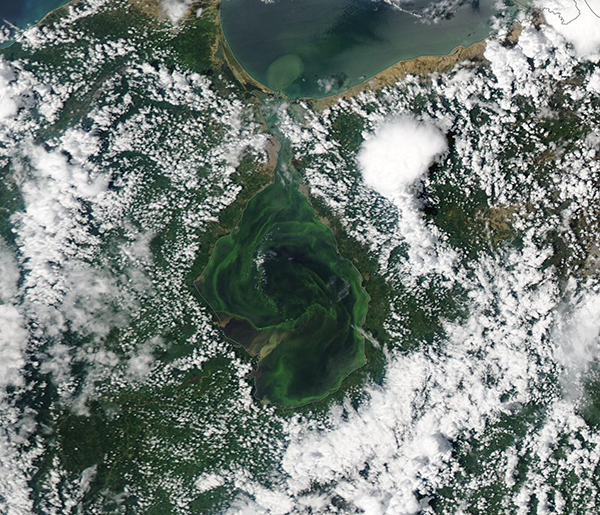Images
October 8, 2021 - Lake Maracaibo
Tweet
It was once a source of great abundance—particularly fossil fuels and fish—for the people of Venezuela. Now Lake Maracaibo is mostly abundant with pollution from leaking oil and excess nutrients.
Spanning 13,000 square kilometers (5,000 square miles) in northwestern Venezuela, Lake Maracaibo is one of South America’s largest lakes and one of the oldest in the world. Though it was filled with freshwater thousands of years ago, Maracaibo is now an estuarine lake connected to the Gulf of Venezuela and the Caribbean Sea by a narrow strait. That strait was significantly expanded in the 1930–50s by dredging for ship traffic. Now the north end of the lake is brackish, while the south end is mostly fresh due to abundant flows from nearby rivers.
On October 1, 2021, the Moderate Resolution Imaging Spectroradiometer (MODIS) on board NASA’s Terra satellite acquired a true-color image showing Lake Maracaibo filled with swirls of green, tan, and gray. The sources of these colors were algae, river sediment outflows, and crude oil leaks. The swirls were created as they were carried by the flow of currents and eddies in the lake.
One of the largest known oil and gas reserves in the world sits beneath Lake Maracaibo. Thousands of wells have been drilled into the lake since World War I, first by foreign companies and then by Venezuela’s state-run oil company. About two-thirds of the oil produced by the country comes from this region.
But the fuel that once made Maracaibo prosperous is now endangering wildlife, water quality, and human health. According to many news and scientific reports, the region’s oil-extraction and delivery infrastructure is in serious disrepair. Slicks have been a regular occurrence on the lake for many years, and crude oil often washes up on the shores.
According to reports from news agencies, environmental groups, and human rights advocates, as many as 40,000 to 50,000 oil leaks and spills occurred between 2010 and 2016 across Venezuela, including Lake Maracaibo. Thousands of oil derricks and thousands of miles of pipelines are decaying or leaking due to a reported lack of capital to repair them. Local fishermen often find their nets and their catch soaked in crude.
The widespread greenery in the water is another sign of distress. Because the lake is overloaded with nutrients, plants such as duckweed (Lemna obscura ) and green algae (such as Scenedesmus and Chlorella) bloom in great abundance. They have become a permanent feature in the lake, with the amount dependent on the seasonal cycles.
Image Facts
Satellite:
Terra
Date Acquired: 10/1/2021
Resolutions:
1km (238.3 KB), 500m (596.3 KB), 250m (433.6 KB)
Bands Used: 1,4,3
Image Credit:
MODIS Land Rapid Response Team, NASA GSFC
Tweet
It was once a source of great abundance—particularly fossil fuels and fish—for the people of Venezuela. Now Lake Maracaibo is mostly abundant with pollution from leaking oil and excess nutrients.
Spanning 13,000 square kilometers (5,000 square miles) in northwestern Venezuela, Lake Maracaibo is one of South America’s largest lakes and one of the oldest in the world. Though it was filled with freshwater thousands of years ago, Maracaibo is now an estuarine lake connected to the Gulf of Venezuela and the Caribbean Sea by a narrow strait. That strait was significantly expanded in the 1930–50s by dredging for ship traffic. Now the north end of the lake is brackish, while the south end is mostly fresh due to abundant flows from nearby rivers.
On October 1, 2021, the Moderate Resolution Imaging Spectroradiometer (MODIS) on board NASA’s Terra satellite acquired a true-color image showing Lake Maracaibo filled with swirls of green, tan, and gray. The sources of these colors were algae, river sediment outflows, and crude oil leaks. The swirls were created as they were carried by the flow of currents and eddies in the lake.
One of the largest known oil and gas reserves in the world sits beneath Lake Maracaibo. Thousands of wells have been drilled into the lake since World War I, first by foreign companies and then by Venezuela’s state-run oil company. About two-thirds of the oil produced by the country comes from this region.
But the fuel that once made Maracaibo prosperous is now endangering wildlife, water quality, and human health. According to many news and scientific reports, the region’s oil-extraction and delivery infrastructure is in serious disrepair. Slicks have been a regular occurrence on the lake for many years, and crude oil often washes up on the shores.
According to reports from news agencies, environmental groups, and human rights advocates, as many as 40,000 to 50,000 oil leaks and spills occurred between 2010 and 2016 across Venezuela, including Lake Maracaibo. Thousands of oil derricks and thousands of miles of pipelines are decaying or leaking due to a reported lack of capital to repair them. Local fishermen often find their nets and their catch soaked in crude.
The widespread greenery in the water is another sign of distress. Because the lake is overloaded with nutrients, plants such as duckweed (Lemna obscura ) and green algae (such as Scenedesmus and Chlorella) bloom in great abundance. They have become a permanent feature in the lake, with the amount dependent on the seasonal cycles.
Image Facts
Satellite:
Terra
Date Acquired: 10/1/2021
Resolutions:
1km (238.3 KB), 500m (596.3 KB), 250m (433.6 KB)
Bands Used: 1,4,3
Image Credit:
MODIS Land Rapid Response Team, NASA GSFC




